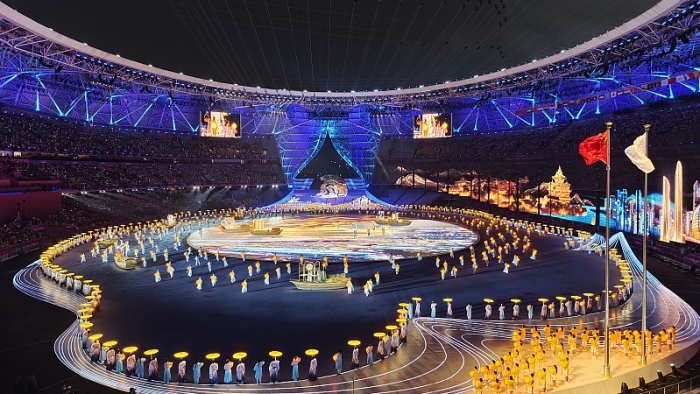The ongoing 19th Asian Games includes Chinese ecological efforts.
Climate protection strategy is fascinating the globe during the 19th Asian Games, not just athletic talent. China, with its centuries-old history and unique culture, is using green measures to promote climate cooperation. Hangzhou city has embraced a practical eco-approach. The emphasis of the Asian Games is on "green, intellectual, frugal, and civilized" contests, reflecting a trend toward more ecologically friendly and sustainable practices in major events. Given current geopolitical tensions, China's attempts to advance international climate change cooperation via the Asian Games are admirable and deserving of praise.
UN Climate Change urges sports organizations and stakeholders to join a new climate action for sports initiative that will define the trajectory and help sports prevail in global climate change objectives. The Hangzhou Games play a significant role in this regard. The Asian Games demonstrate how China is leading the charge for rapid climate action and climate protection. Through innovative collaborations that bring together statesmen, athletes, sports federations, and spectators, the Asian Games pave the path for international climate cooperation.
On September 19, UN Secretary-General Antonio Guterres spoke at the UN General Assembly climate summit on the challenges of balancing economic development with environmental protection. The Asian Games demonstrate how economic progress and environment conservation could be balanced.
The Asian Games in Hangzhou demonstrate how climate collaboration should prompt countries to cooperate, build climate-friendly infrastructure, tear down boundaries, and create a global narrative of friendliness and cooperation. It's about stimulating climate collaboration across countries, establishing bridges, developing ties, and leaving an enduring impact on international relations, not simply runs and wickets. It illustrates that climate-friendly events are achievable.

Although sport contributes to and suffers from global warming, China demonstrates climate protection in sports activities. China sets an example here. Its climate protection potential is unique. The events' wide local, regional and global reach makes it an effective tool for building climate awareness. The Asian Games can promote a healthy, sustainable lifestyle and educate people about global warming and other environmental challenges. In order to ensure sustainable development, the Games have low-cost, high-impact solutions for achieving climate security.
The Hangzhou Asian Games place a strong emphasis on eco-friendly packaging, production, recycling, and design. An energy source with a minimal carbon footprint will be used to light the Asian Games' main torch in Hangzhou. On September 23, the main torch for the Asian Games was ignited using environmentally friendly gasoline.
Avoiding fireworks during the opening ceremony promotes environmental awareness. Traditional fireworks displays are fun but pollute the air. The Asian Games intend to exhibit a commitment to sustainability while providing an engaging and memorable experience for all guests by replacing this spectacle with digitally powered visual effects and sound presentations.
The Asian Games will be eco-friendly without sacrificing enthusiasm or competition. This dedication is shown by the opening ceremony's fireworks ban, establishing a precedent for future sporting events and stressing sustainability without losing excellence.
For eight years, China has led the globe in new energy vehicle sales, renewable energy development, wind power, and solar installations. Green technology is a highlight of the 19th Asian Games, from wind, solar, and other clean energy-powered sports arenas to autonomous buses and digital torchbearers. China's low-carbon progress is shown through Hangzhou Asian Games' green technologies. The event demonstrates China's low-carbon development commitment. For example, according to media reports, Hangzhou is supporting electric cars and green transportation.
The Asian Games' eco-friendly licensed items include backpacks constructed from 10 recycled bottles and frisbees manufactured from 1,000 grams of rice husks. As all Asian Games venues and infrastructures employ green energy, the event's green elements demonstrate China's recent green transformation and its responsibility and commitment to meeting its dual carbon goals. Hangzhou's green and high-tech development ideals would inspire foreign delegates and other Chinese cities to pursue low-carbon, innovation-driven growth via the Games.
Chen Rong, 19th Asian Games Organizing Committee venue construction and management director, stated that the Asian Games' green electricity agreement currently totals 220 million kilowatt-hours, lowering carbon dioxide emissions by 115,400 tons. Games mascots are revolutionary in sustainability.
Digital printing produces no wastewater, gas, or pulp, unlike older processes. Instead of lasers, employees cut the mascots using electric scissors to reduce air pollution. Photovoltaics on the factory roof powered the mascots. Mascots are another creative component of the Asian Games. The cloth for these mascots was digitally printed. This avoids typical printing waste of water, gas, and pulp.
Energy-efficient structures show the Asian Games' green approach to arranging the sports spectacular. The event showcases innovative municipal management and public service models in China and promotes green, low-carbon, and sustainable development. The event's green aspects demonstrate China's recent green transition and duty to fulfill its dual carbon objectives.
The Games Village gave residents a "Low Carbon Account" as part of its green measures. Carbon points were used to promote low-carbon habits including plate recycling, green commuting, and plastic-free purchasing. Points may be traded for low-carbon Olympic mascots and other prizes. Water recycling systems help sustainability in many places. Example: Fuyang Water Sports Center.
However, eco-sustainability is the goal of the improvements. Hangzhou's ingenious water-saving method shows its sustainability and eco-friendliness. The venues use green power to demonstrate Hangzhou's commitment to a carbon-neutral Asian Games. This supports worldwide green energy and carbon reduction efforts. These stations enable efficient charging to promote green mobility.
China has made progress in addressing climate change via energy savings, carbon reduction, emissions reduction, and carbon market development. Hangzhou's 19th Asian Games strategy symbolizes a new age of green and sustainable large-scale events. The use of green power, water recycling, eco-friendly printing, and wireless Vehicle-to-Grid (V2G) charging stations shows a trend toward sustainability and environmental concern. This decision benefits the environment and establishes a new norm for large-scale sports and events. Hangzhou City is demonstrating how large-scale events can be fun and green.
China continues to implement a climate change policy, develop a carbon market, and participate in global climate governance. China aims to peak and neutralize carbon dioxide emissions by 2030 and 2060. The green Asian Games proves this.
Farhad Chowdhury is a special commentator for CGTN, is a security and strategic affairs researcher and columnist.
The article was published by CGTN.
More about:
















































